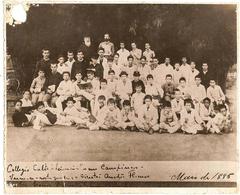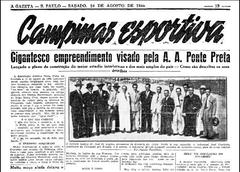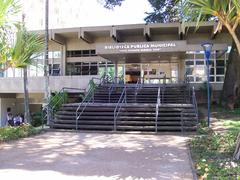
Palácio dos Azulejos Visiting Hours, Tickets, and Historical Site Guide – Campinas, Brazil
Date: 03/07/2025
Introduction
Located in the heart of Campinas, Brazil, the Palácio dos Azulejos is a singular architectural and cultural landmark. Renowned for its stunning blue-and-white Portuguese tile (azulejo) façade, this 19th-century palace stands as a testament to Campinas’ historical evolution—from an aristocratic coffee boomtown to a modern urban center. Now home to the Museu da Imagem e do Som (MIS), the palace offers visitors free access to a living repository of the city’s audiovisual, architectural, and civic heritage. This guide provides comprehensive, non-duplicative information on the palace’s history, architecture, visiting hours, ticketing, accessibility, and tips for making the most of your visit.
(Campinas.com.br, Live the World, IPHAN)
Table of Contents
- Introduction
- Historical Overview
- Architectural Features and Artistic Highlights
- Preservation and Adaptive Reuse
- Visiting Information
- Nearby Attractions and Travel Tips
- Visitor Experience: What to Observe
- Frequently Asked Questions (FAQ)
- Visual Documentation
- Conclusion and Recommendations
- References
Historical Overview
Origins and Construction
Built in 1878 at the height of Campinas’ coffee-driven prosperity, the Palácio dos Azulejos was commissioned by Joaquim Ferreira Penteado, the Barão de Itatiba. The building incorporates two adjoining mansions, each with its own entrance, unified by a neoclassical design and the spectacular Portuguese azulejos imported from Porto. These tiles, covering the upper façade, gave the palace its name and serve as a powerful visual link to the city’s Portuguese heritage (IPHAN).
Civic Transformation
For its first three decades, the palace was a symbol of Campinas’ elite. In 1908, it was repurposed as City Hall and a courthouse, anchoring it in the city’s public and political life until 1968. After a period of neglect, successful heritage campaigns led to its listing by IPHAN (1967), CONDEPHAAT (1981), and CONDEPACC (1988), ensuring protection at all administrative levels (Promemória Campinas).
Modern Use
Since 1996, the palace has housed the Museu da Imagem e do Som (MIS), integrating historical preservation with contemporary cultural programming. Its adaptive reuse has revitalized the structure while maintaining its historical integrity.
Architectural Features and Artistic Highlights
Façade and Materials
The palace’s neoclassical façade, clad entirely in blue-and-white azulejos, is its most distinguishing feature. The tiles not only decorate but also protect the rammed earth and brick walls, reflecting both aesthetic and practical considerations. Ornate parapets, pilasters, and cast-iron balconies further exemplify the craftsmanship of the late 1800s (IPHAN).
Interior Spaces
Inside, visitors encounter high-ceilinged rooms, a central skylight with colored glass, stucco moldings, and remnants of original marble flooring. The integration of imported materials—marble, metalwork, and glass—underscores the cosmopolitan ambitions of Campinas’ 19th-century elite.
Artistic Significance
The azulejos themselves are a highlight: intricate cobalt blue motifs on white backgrounds, symbolizing both affluence and Campinas’ Portuguese connections. Select interior spaces feature decorative tile panels and painted wall details preserved or restored during conservation efforts.
Preservation and Adaptive Reuse
Restoration projects, particularly the 2004 initiative supported by Petrobras, have stabilized the structure, cleaned the façade, and restored key decorative elements. Local activists and heritage organizations were instrumental in saving the palace from demolition, transforming it into a protected monument and vibrant cultural venue (Hora Campinas).
Today, the Museu da Imagem e do Som (MIS) occupies the building, offering exhibitions, workshops, film screenings, and events. The interplay between contemporary programming and historical architecture creates a dynamic, engaging visitor experience (Live the World).
Visiting Information
- Address: Rua Regente Feijó, 859 – Centro, Campinas, São Paulo, 13013-051
- Opening Hours: Monday to Friday, 9:00 AM–5:00 PM; selected weekends, 10:00 AM–4:00 PM (verify with MIS website for special events and exceptions)
- Ticket Prices: General admission is free; some special events may require tickets or registration.
- Accessibility: Wheelchair accessible with ramps and adapted facilities. Contact the museum in advance for specific needs.
- Getting There: Centrally located, accessible by public transportation, taxi, or on foot from other city sites. Nearby parking available.
Nearby Attractions and Travel Tips
- Catedral Metropolitana de Campinas: A prominent cathedral within walking distance.
- Museu de História Natural: Explore local natural history.
- Carlos Gomes Square: Ideal for photos and relaxation.
- Praça da Catedral: Bustling square with shops and cafés.
Photography: The tile façade is best photographed in natural daylight. Interior photography is allowed for personal use; avoid flash and tripods.
Visitor Tips:
- Schedule visits around workshops/exhibitions for added value.
- Combine your visit with other downtown sites.
- Most exhibits are in Portuguese; staff can often assist non-Portuguese speakers.
Visitor Experience: What to Observe
Key highlights include:
- The blue-and-white azulejo façade
- Main portal with carved wood and classical details
- Cast-iron balcony railings
- Central skylight with colored glass
- Surviving marble floors and stucco decorations
- Temporary and permanent exhibitions at MIS
- Interactive art installations utilizing historic spaces
Frequently Asked Questions (FAQ)
What are the Palácio dos Azulejos visiting hours?
Generally, Monday to Friday, 9:00 AM–5:00 PM; selected weekends 10:00 AM–4:00 PM. Confirm on the official website for updates.
Is there an entrance fee?
Admission is free. Special events may require tickets or registration.
Are guided tours available?
Yes, by appointment for groups, schools, and tourists.
Is the site accessible for people with disabilities?
Yes, with ramps and adapted restrooms. Contact in advance for assistance.
Can I take photos?
Yes, for personal use. Flash and tripods are not permitted.
What other attractions are nearby?
Catedral Metropolitana, Museu de História Natural, Carlos Gomes Square, and local cafés.
Visual Documentation
- Façade: High-resolution images of the vibrant azulejo tilework (alt text: “Palácio dos Azulejos blue-and-white Portuguese tile façade in Campinas”).
- Interiors: Shots of ornate tilework, woodwork, and exhibition spaces (alt text: “Interior of Palácio dos Azulejos with historic details and museum exhibits”).
- Maps: Downtown Campinas map highlighting the palace’s location.
- Virtual Tours: Explore online galleries and virtual tours via the official museum website.
Conclusion and Recommendations
The Palácio dos Azulejos is more than a preserved relic—it is a living center of culture, education, and community engagement. Its architectural beauty, free access, and dynamic programming make it a must-see for anyone interested in Brazilian history or contemporary arts. Plan your visit in advance, check for current exhibitions, and enjoy the rich heritage that this Campinas icon has to offer. For the latest updates, download the Audiala app, follow the museum on social media, and consult official sources listed below.
References
- Campinas.com.br
- Live the World
- IPHAN
- Hora Campinas
- Promemória Campinas
- Campinas Tourism Portal: https://campinas.sp.gov.br/cultura






